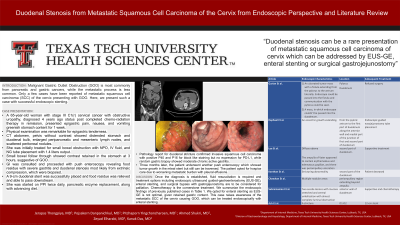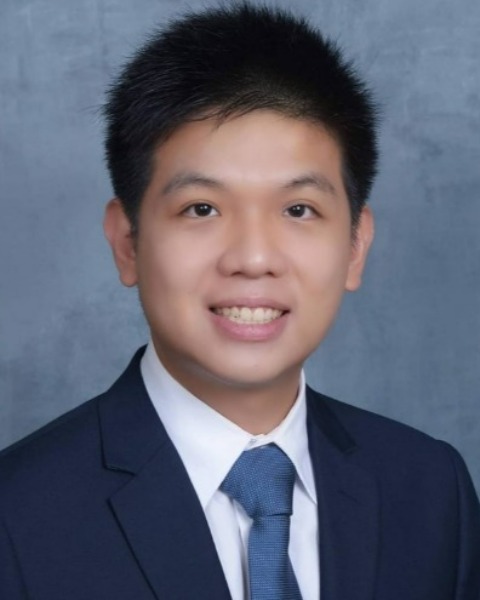Tuesday Poster Session
Category: Small Intestine
P4944 - Duodenal Stenosis from Metastatic Squamous Cell Carcinoma of the Cervix From Endoscopic Perspective and Literature Review
Tuesday, October 29, 2024
10:30 AM - 4:00 PM ET
Location: Exhibit Hall E

Has Audio

Jerapas Thongpiya, MD
Texas Tech University Health Sciences Center
Lubbock, TX
Presenting Author(s)
Jerapas Thongpiya, MD, Pojsakorn Danpanichkul, MD, Pitchaporn Yingchoncharoen, MD, Ahmed Shukri, MD, Zeyad Elharabi, MD, Kanak Das, MD
Texas Tech University Health Sciences Center, Lubbock, TX
Introduction: Malignant Gastric Outlet Obstruction (GOO) is most commonly from pancreatic and gastric cancers, while the metastatic process is less common. Only a few cases have been reported of metastatic squamous cell carcinoma (SCC) of the cervix presenting with GOO. Here, we present such a case with successful endoscopic stenting.
Case Description/Methods: A 65-year-old woman with stage III C1(r) cervical cancer with obstructive uropathy, diagnosed 4 years ago status post completed chemo-radiation therapy in remission, presented epigastric pain, nausea, and vomiting greenish stomach content for 1 week. Physical examination was remarkable for epigastric tenderness. CT abdomen, pelvis without contrast showed distended stomach and duodenal bulb, enlarged peripancreatic and mesenteric lymph nodes, and scattered peritoneal nodules. She was initially treated for small bowel obstruction with NPO, IV fluid, and NG tube placement with 1.4 liters output. Small bowel follow through showed contrast retained in the stomach at 3 hours, suggestive of GOO. GI was consulted and proceeded with push enteroscopy revealing food residue with severe gastritis and duodenal stenosis most likely from extrinsic compression, which were biopsied. A 9-cm duodenal stent was successfully placed and food residue was relieved and able to pass downstream. She was started on PPI twice daily, pancreatic enzyme replacement, along with advancing diet. Pathology report for duodenal stricture confirmed Invasive squamous cell carcinoma with positive P40 and P16 for block like staining but no expression for PD-L1, while random gastric biopsy showed moderate chronic active gastritis. Three months later, the patient underwent another push enteroscopy which showed tumor growth in the mteal stent but still can be traversed. The patient opted for hospice care due to worsening metastatic burden with pleural effusions.
Discussion: Once the diagnosis is established, fluid resuscitation is required and treatment options including endoscopic ultrasound guided-gastroenterostomy (EUS-GE), enteral stenting, and surgical bypass with gastrojejunostomy are to be considered for palliation. Chemotherapy is the cornerstone treatment. We summarize the endoscopic findings of previously published cases in Table 1. We opted for enteral stenting as EUS-GE is not optimal, given retained gastric content. This case raises awareness of the metastatic SCC of the cervix causing GOO, which can be treated endoscopically with enteral stenting.

Note: The table for this abstract can be viewed in the ePoster Gallery section of the ACG 2024 ePoster Site or in The American Journal of Gastroenterology's abstract supplement issue, both of which will be available starting October 27, 2024.
Disclosures:
Jerapas Thongpiya, MD, Pojsakorn Danpanichkul, MD, Pitchaporn Yingchoncharoen, MD, Ahmed Shukri, MD, Zeyad Elharabi, MD, Kanak Das, MD. P4944 - Duodenal Stenosis from Metastatic Squamous Cell Carcinoma of the Cervix From Endoscopic Perspective and Literature Review, ACG 2024 Annual Scientific Meeting Abstracts. Philadelphia, PA: American College of Gastroenterology.
Texas Tech University Health Sciences Center, Lubbock, TX
Introduction: Malignant Gastric Outlet Obstruction (GOO) is most commonly from pancreatic and gastric cancers, while the metastatic process is less common. Only a few cases have been reported of metastatic squamous cell carcinoma (SCC) of the cervix presenting with GOO. Here, we present such a case with successful endoscopic stenting.
Case Description/Methods: A 65-year-old woman with stage III C1(r) cervical cancer with obstructive uropathy, diagnosed 4 years ago status post completed chemo-radiation therapy in remission, presented epigastric pain, nausea, and vomiting greenish stomach content for 1 week. Physical examination was remarkable for epigastric tenderness. CT abdomen, pelvis without contrast showed distended stomach and duodenal bulb, enlarged peripancreatic and mesenteric lymph nodes, and scattered peritoneal nodules. She was initially treated for small bowel obstruction with NPO, IV fluid, and NG tube placement with 1.4 liters output. Small bowel follow through showed contrast retained in the stomach at 3 hours, suggestive of GOO. GI was consulted and proceeded with push enteroscopy revealing food residue with severe gastritis and duodenal stenosis most likely from extrinsic compression, which were biopsied. A 9-cm duodenal stent was successfully placed and food residue was relieved and able to pass downstream. She was started on PPI twice daily, pancreatic enzyme replacement, along with advancing diet. Pathology report for duodenal stricture confirmed Invasive squamous cell carcinoma with positive P40 and P16 for block like staining but no expression for PD-L1, while random gastric biopsy showed moderate chronic active gastritis. Three months later, the patient underwent another push enteroscopy which showed tumor growth in the mteal stent but still can be traversed. The patient opted for hospice care due to worsening metastatic burden with pleural effusions.
Discussion: Once the diagnosis is established, fluid resuscitation is required and treatment options including endoscopic ultrasound guided-gastroenterostomy (EUS-GE), enteral stenting, and surgical bypass with gastrojejunostomy are to be considered for palliation. Chemotherapy is the cornerstone treatment. We summarize the endoscopic findings of previously published cases in Table 1. We opted for enteral stenting as EUS-GE is not optimal, given retained gastric content. This case raises awareness of the metastatic SCC of the cervix causing GOO, which can be treated endoscopically with enteral stenting.

Figure: CT abdomen and pelvis revealed a distended stomach and duodenal bulb, enlarged peripancreatic and mesenteric lymph nodes, and scattered peritoneal nodules.
Push enteroscopy showed severe gastritis with retained bilious stomach content and duodenal stenosis from extrinsic compression with successful enteral stenting.
Push enteroscopy showed severe gastritis with retained bilious stomach content and duodenal stenosis from extrinsic compression with successful enteral stenting.
Note: The table for this abstract can be viewed in the ePoster Gallery section of the ACG 2024 ePoster Site or in The American Journal of Gastroenterology's abstract supplement issue, both of which will be available starting October 27, 2024.
Disclosures:
Jerapas Thongpiya indicated no relevant financial relationships.
Pojsakorn Danpanichkul indicated no relevant financial relationships.
Pitchaporn Yingchoncharoen indicated no relevant financial relationships.
Ahmed Shukri indicated no relevant financial relationships.
Zeyad Elharabi indicated no relevant financial relationships.
Kanak Das indicated no relevant financial relationships.
Jerapas Thongpiya, MD, Pojsakorn Danpanichkul, MD, Pitchaporn Yingchoncharoen, MD, Ahmed Shukri, MD, Zeyad Elharabi, MD, Kanak Das, MD. P4944 - Duodenal Stenosis from Metastatic Squamous Cell Carcinoma of the Cervix From Endoscopic Perspective and Literature Review, ACG 2024 Annual Scientific Meeting Abstracts. Philadelphia, PA: American College of Gastroenterology.
